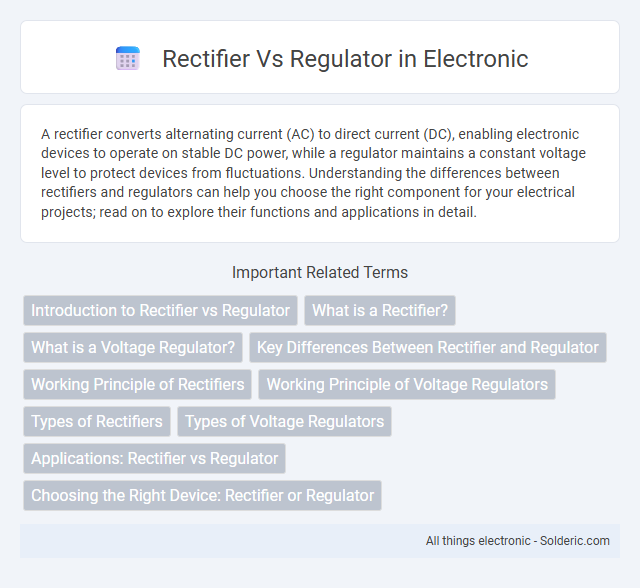A rectifier converts alternating current (AC) to direct current (DC), enabling electronic devices to operate on stable DC power, while a regulator maintains a constant voltage level to protect devices from fluctuations. Understanding the differences between rectifiers and regulators can help you choose the right component for your electrical projects; read on to explore their functions and applications in detail.
Comparison Table
| Feature | Rectifier | Regulator |
|---|---|---|
| Function | Converts AC to DC | Maintains constant DC output voltage |
| Primary Use | Power supply conversion | Voltage stabilization |
| Output Type | Pulsating DC | Steady DC voltage |
| Types | Half-wave, Full-wave, Bridge rectifiers | Linear, Switching regulators |
| Key Components | Diodes | Transistors, Zener diodes, ICs |
| Voltage Control | No voltage regulation | Regulates output voltage precisely |
| Efficiency | Moderate | High (especially switching types) |
| Applications | Power supplies, Battery charging | Power supply circuits, Electronics requiring stable voltage |
Introduction to Rectifier vs Regulator
A rectifier converts alternating current (AC) to direct current (DC) by allowing current flow in only one direction, essential for powering DC devices. A regulator maintains a constant output voltage or current despite variations in input voltage or load conditions, ensuring stable performance and protecting your electronic circuits. Understanding the differences between a rectifier and a regulator is crucial for designing reliable power supply systems.
What is a Rectifier?
A rectifier is an electrical device that converts alternating current (AC) to direct current (DC) by allowing current to flow in only one direction. It is commonly used in power supplies to transform AC voltage from the mains into DC voltage suitable for electronic circuits. Types of rectifiers include half-wave, full-wave, and bridge rectifiers, each differing in efficiency and application.
What is a Voltage Regulator?
A voltage regulator is an electronic device designed to maintain a constant output voltage despite variations in input voltage or load conditions. Unlike a rectifier that converts AC to DC, a voltage regulator stabilizes the DC voltage to ensure reliable performance of electronic circuits. Common types include linear regulators and switching regulators, each optimized for efficiency and precision in power management.
Key Differences Between Rectifier and Regulator
A rectifier converts alternating current (AC) into direct current (DC) by allowing current to flow in only one direction, whereas a regulator maintains a constant output voltage regardless of input voltage variations or load changes. Rectifiers are primarily used in power supply circuits to produce DC from AC sources, while regulators ensure the stability of the DC voltage supplied to electronic components. Understanding the key difference helps you choose the right component for converting or stabilizing electrical energy in your system.
Working Principle of Rectifiers
Rectifiers convert alternating current (AC) to direct current (DC) by allowing current flow in only one direction through semiconductor diodes. They use half-wave or full-wave configurations to produce pulsating DC voltage, which can then be smoothed or filtered. Your electronic devices rely on rectifiers to provide the stable DC power needed for proper operation.
Working Principle of Voltage Regulators
Voltage regulators maintain a constant output voltage by adjusting the current flow through their internal components, compensating for variations in input voltage or load conditions. Unlike rectifiers, which convert AC to DC, voltage regulators stabilize the DC voltage to prevent fluctuations that could damage electronic circuits. Your devices rely on voltage regulators to ensure stable and reliable performance despite changes in power supply or operating environment.
Types of Rectifiers
Rectifiers convert alternating current (AC) to direct current (DC) and come in several types including half-wave, full-wave center-tap, and full-wave bridge rectifiers, each varying in efficiency and complexity. Half-wave rectifiers use a single diode and allow current flow during only one half of the AC cycle, making them less efficient for power applications. Full-wave rectifiers utilize either a center-tapped transformer with two diodes or four diodes in a bridge configuration to produce a smoother DC output, essential for stable power supply in your electronic devices.
Types of Voltage Regulators
Voltage regulators come in various types, including linear regulators and switching regulators, each designed to maintain a stable output voltage despite fluctuations in input voltage or load conditions. Linear regulators, such as the popular 7805 series, provide a smooth, low-noise output ideal for sensitive analog circuits, while switching regulators offer higher efficiency and are suitable for battery-powered devices or applications requiring significant power conversion. Understanding the differences in voltage regulator types helps you select the appropriate solution to protect your electronics and ensure consistent performance.
Applications: Rectifier vs Regulator
Rectifiers are primarily used in power supplies to convert alternating current (AC) to direct current (DC), essential for devices requiring stable DC input such as battery chargers and DC motors. Regulators maintain a constant output voltage regardless of input voltage fluctuations or load changes, critical in sensitive electronics like microprocessors and communication equipment. Understanding the applications of rectifiers and regulators ensures your electronic systems operate efficiently and reliably under varying power conditions.
Choosing the Right Device: Rectifier or Regulator
Choosing the right device depends on your circuit's purpose: rectifiers convert AC to DC by allowing current flow in one direction, ideal for power supply conversion. Regulators maintain a constant output voltage regardless of input variations, protecting sensitive electronics from fluctuations. Understanding whether you need voltage conversion or voltage stabilization will guide your selection between a rectifier and a regulator.
rectifier vs regulator Infographic

 solderic.com
solderic.com